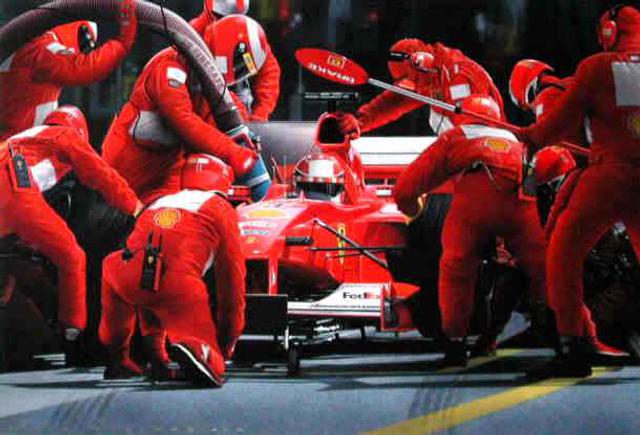Top ten techniques for fresh thinking
- Written by
- Lucy Gower
- Added
- November 11, 2010

Our brains are masters at ‘filling in the blanks’. We see something, compare it to our store of past memories, reach a conclusion and then act on it.
This pattern-recognising ability of ours is a very useful tool. It saves us time, lets us make decisions on the fly, and helps us interpret our world.

Stereotyping is the most obvious manifestation of this phenomenon, causing us to jump to conclusions. But our conclusions are not always right. In our hurry to make sense of the world, we prematurely ‘fill in the blanks’, trading in reality for reactivity.
Patterns are the raw material from which we interpret our world. However, they can hinder our creativity because time and time again our thinking falls into the same patterns. In order to be more creative we need to break the model and approach challenges from a fresh perspective.
‘Insanity: doing the same things over and over again and expecting different results’. Albert Einstein

There are lots of tactics that you can use to break patterns in your everyday life that will help you develop new ideas and connections. In a creative ideas session, when you want lots of fresh ideas, you need to structure the session and deliberately help participants to approach the challenge from a fresh perspective if you are really going to get different results. I suggest using at least two techniques per challenge to make the most of the creative session.
Here are some simple techniques to get you started. Remember this is about pattern breaking and getting lots of ideas. Don’t judge or critique anything at this stage. Write down everything, even the ideas you think are crazy. For more help check out my tips on getting the best out of your creative session.

1. Someone else’s shoes
First think of a person/character who could add a different perspective to your challenge. The more different the person is from you the better. (My personal favourites are Homer Simpson and Postman Pat.) Quickly write down all their characteristics, include everything and anything that comes into your head, try to get a real feel for the person whose shoes you are stepping into. Then ask yourself, ‘If Homer were faced with this challenge what would he do?’ List everything that comes into your mind.
2. Ask ‘what if?’
Turn the ‘rules’ of the challenge you are solving on its head by asking what if? First consider these ‘rules’, for example in the case of a mailing with a donation form there are ‘normal’ donation values. So ask what if we asked for the full amount that we need – rather than the standard amounts of £5, £10, £25 and £50 donation. Greenpeace did this with a brilliant result. Check the story here.
3. Related worlds
Think about where else in the world your challenge is being faced and consider what solutions you can steal. Think about companies facing similar challenges. A great example of this thinking is ColaLife who asked, ‘Why can you get a Coca-Cola everywhere, yet aid organisations struggle to get medical supplies to rural areas?’ ColaLife identified that Coca-Cola have amazingly effective distribution networks that they could learn from and use. ColaLife are now piloting how they can best borrow from Coca-Cola’s expertise to distribute life-saving medicines.
Heart surgeons from Great Ormond Street, a London children’s hospital, identified Formula 1 pit stop teams for inspiration in how to speed up their processes. So, first think broadly about what your challenge is, identify where else in the world a similar challenge is being addressed successfully and apply that solution to your challenge.
4. Random words
Get some dictionaries and ask people to put a pin in a page to pick a word at random. Now force connections with the random word and your challenge. For example if your challenge is to develop a new fundraising event and your word was wasp your thought process might go like this:
Wasps, summertime, ice creams, honey, sweet food and picnics make me think of being a child, being scared of wasps and getting stung, and they hover about, and are stripey and buzz. So, buzzer makes me think of quiz games, buzzing for the right answer, could have summertime quiz, maybe outside, a family picnic with prizes, fancy dress, people wear stripes, or a treasure hunt where you win a trip to America, stars and stripes… Just keep going and see what you get. It’s really important that you pick the first word and don’t choose a word that you like. The more random the word appears to be to the challenge, the more patterns you will be breaking – which is the whole point.
5. Be silly
Set a rule where you only allow outrageously ridiculous and impossible solutions. Be a true escapist, there are no morals, rules, etiquette, laws, or standards. Escape the physical limitations of the world to see what your ultimate solution would be. Once you have done this, look back at the ideas you have generated. Then you should look for ways in which all or part of these ideas could be made practical. Think of the benefits you could gain by using the idea and work out how you can achieve the same thing in reality. How could you modify the suggested solution to make it work? How could you get the same effect? What changes in the world would you need to make the idea possible and how can you make those changes happen?
6. Use pictures
Choose a picture, anything at all, and extract a concept or idea from it. Then use this idea to stimulate a possible solution to your challenge. Try to see anything in the picture that reminds you of your challenge and how it might be solved. What activities are going on? What situations are being faced? Why are the people doing what they are doing? What principles are being used? Next think of how you can use that new situation/object/attitude in your own situation.
7. Make it urgent
Write a headline that makes your challenge urgent and critical. For example, ‘XXX charity loses all donors because of failure to send thank- you letters on time. Services are closing. Heads will roll says chief exec’. Or, ‘If you don’t send thank-you letters on time the repercussions are grave. Action is needed immediately’. What will you do?
8. Turn the challenge upside down
Consider the opposite of your challenge. For example, rather than trying to get regular donors to give more money each month, what actions would you take to get them to give less? This could include writing rude letters, never writing, telling them their money gets wasted on expensive lunches for trustees. Then think about the opposite of your suggestions: write them poetry, write more regularly, phone them or text them and provide a breakdown of how their donation makes a difference. You will be surprised at how many answers you get from tackling the challenge from an opposite viewpoint.
9. Mind tiles
This is where you take two themes and force a connection. So, if your challenge is to come up with a new product for Christmas fundraising, first write down on post-it notes everything you can think of to do with Christmas. Then write down everything you can think of to do with fundraising. Put combinations together; pair the most unlikely. Then work on the unlikely pairings to make them into a fundraising idea. Snowboarding was invented using this technique, a combination of skiing and skateboarding.
10. Draw a picture
Express your challenge as a picture; you can do this with pens and paper and/or a collage using newspapers and magazine cuttings for those who feel intimidated by drawing. Express your challenge in picture format and discuss the results, e.g. if your challenge was how to engage the whole organisation in innovation, how would you draw that visually? A beautiful garden with lots of seeds, or a barren landscape overrun with too many chiefs? This technique helps people to express difficult challenges by using metaphors that help to bring the ‘real’ challenge into the open.
Remember your brain is an amazingly powerful and complex organ. It is estimated that there are 100 billion neurons creating over 100 trillion synapses or connections between cells. Synapses are the building blocks of our thoughts ideas and memories. Your brain consumes a quarter of the calories you use and a quarter of the oxygen you breathe – think of it as the most powerful muscle in your body. Use these techniques to give your brain a workout, help to break patterns and create new connections. This is the key to developing fresh thinking and breakthrough ideas.
For more ways to break patterns I recommend reading:
Think! by Tina Catling and Mark Davies, Capstone Publishers.
Sticky wisdom by Dave Allan, Matt Kingdon, Kris Murrin and Daz Rudkin, Capstone Publishers.
How to be a brilliant thinker by Paul Sloane, Kogan Page
Rousing creativity by Floyd Hurt, Crisp Publications.
© Lucy Gower's article was first published on SOFII in 2010.

















